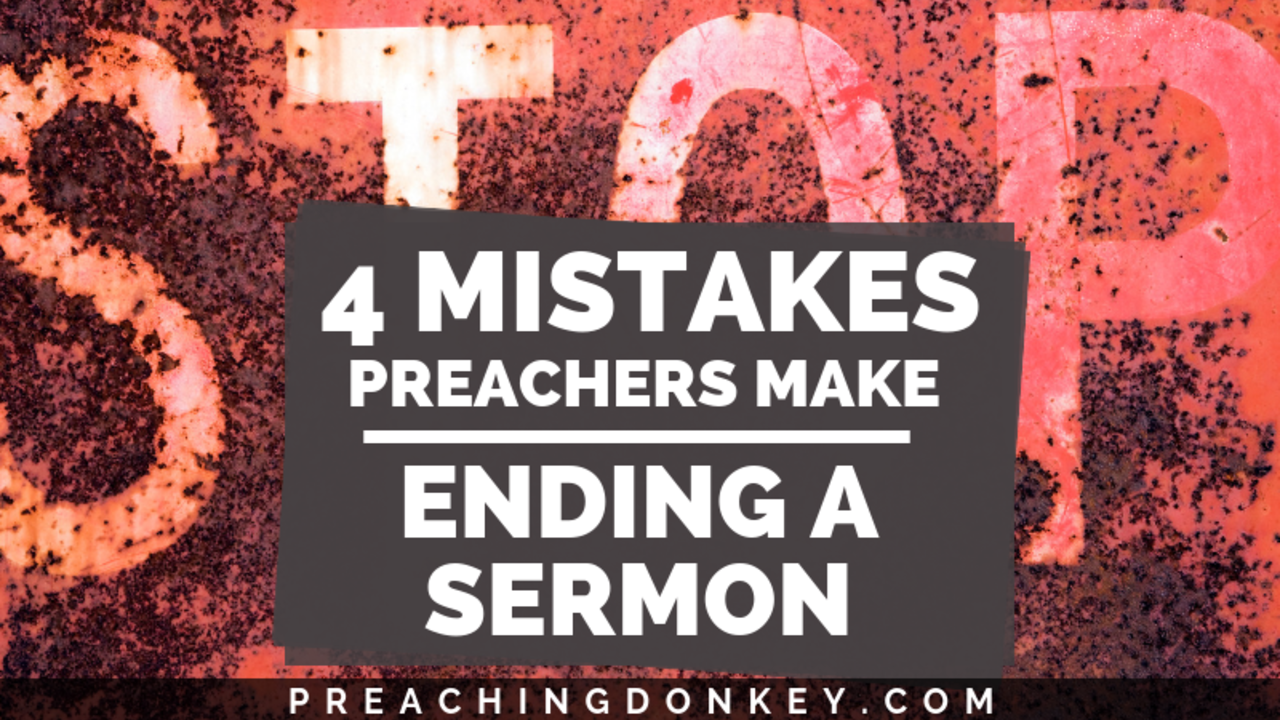4 Mistakes Preachers Make When Ending a Sermon

How you begin your sermon is vital. It can mean the difference between your listeners checking out or deciding to pay close attention. The things you say at the beginning of a sermon are what your listeners subconsciously use to build a framework for your whole message. If your thoughts are murky and unclear, you’re laying an unstable foundation.
But the way you end a sermon is just as important. If the closing of your message is disorganized and unclear, then your listeners will walk away feeling the same way about your message – that it was disorganized and unclear. I’ve written extensively about the important role you play as the communicator in setting the tone for how your audience perceives your message.
When I first began preaching I would prepare relentlessly for the first five minutes of my sermon. I wanted my opening thoughts to be perfect. I would prepare the opening remarks and the body of the sermon with careful detail. But when it came to the end of my message I would just let the sermon kind of close itself. I didn’t have a plan for ending my sermons most of the time.
The result was a lot of missed opportunities where I could have had a much sharper impact if I had called people to action or drove a point home. Instead, I just winged most of them. I have learned from these mistakes and I now plan much better for closing my sermons. I want to share with you some of the mistakes I have made because a lot of preachers make the same ones. Here are four common mistakes preachers make when ending a sermon:
1. Ending too abruptly. A sermon is a conversation. Even though you may be the only one talking; you are having a conversation with your people. Like any other conversation it is better when it ends naturally.
In real life we give each other cues when a conversation is about to end. We don’t just walk away when we feel like the discussion is over. We make sure the other person knows the conversation is ending. We give them a chance to prepare for the conversation to be finished.
When you preach, your listeners need to know the end is coming before it happens. You don’t have to announce it. Rather, you just need to give some cues that the sermon is coming to a close so your people aren’t caught off guard. In his book, Communicating for a Change, Andy Stanley discusses the effect it has on an audience when the sermon is ended too abruptly. He compares it with sitting in the passenger seat of a car and the driver slamming on the brakes. It’s alarming and it takes you off guard.
Giving no indication that your sermon is about to end and just saying, “Let’s pray” feels like slamming on the brakes to your listeners. Take some time, breathe a little, and prepare your people for the the ending.
2. Ending too slowly. On the other end of the spectrum is to take too long to close. A long, droning ending to a sermon can be just as bad as an abrupt one.
I had a pastor growing up who would say, “And one more thing as we close…. 15 minutes later… and one more thing as we close.” I couldn’t trust him. It was frustrating.
A natural ending to a conversation doesn’t go on forever. Give people an appropriate amount of time to know your sermon is ending, point their thoughts in the direction you want them to go, and end it in a timely way.
Continuing to ramble at the end of a message is one of the best ways to kill the effectiveness of your content. I wrote all about it here.
3. Restating your whole sermon in summary form. Restating your points is fine. Restating the most important point is even better. But where most pastors go wrong is when they use the last few minutes to say everything they’ve already said – just one more time. The old, “Tell ’em what you’re gonna tell ’em, tell ’em, tell ’em what you told ’em.
This is not a good usage of your closing. You should use the body of your sermon to preach your sermon. Use the end to drive the point home, give application, call to action, challenge, inspire, or encourage. Your ending is when you make your message stick.
Don’t use those valuable moments at the end of the message to say what you’ve already said in the same way you’ve already said it.
4. Failing to give a clear application or way to respond. One of the things that makes a sermon different from other mediums like lectures or lessons is that a sermon is a call to action. To sermonize is to motivate people to change course, to live differently, to think differently, to do something.
You want your sermon to give people some handles to grab onto. The closing is a perfect opportunity to introduce or reinforce the application of your sermon. What do you want your people to do as a result of what they just heard? What do you want them to think? How should they respond? The closing of your sermon should make these questions crystal clear in everyone’s mind.
I’ve written a book that describes in-depth how all of these principles come together. It’s called Preaching Killer Sermons: How to Create and Deliver Messages that Captivate and Inspire Check it out and discover more ways to sharpen the impact of your messages.
These are the four mistakes I have had to work through. I have not mastered my sermon endings, but I try to avoid these mistakes as much as I can. What are some other mistakes preachers make while ending a sermon? What do you do to end your messages?


